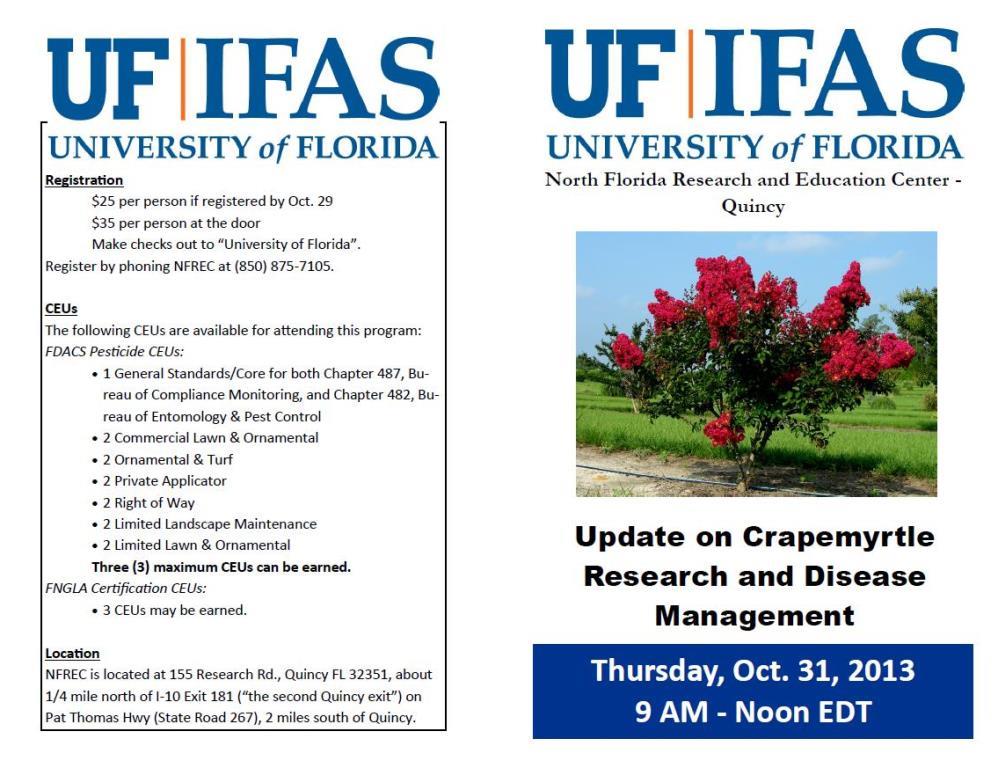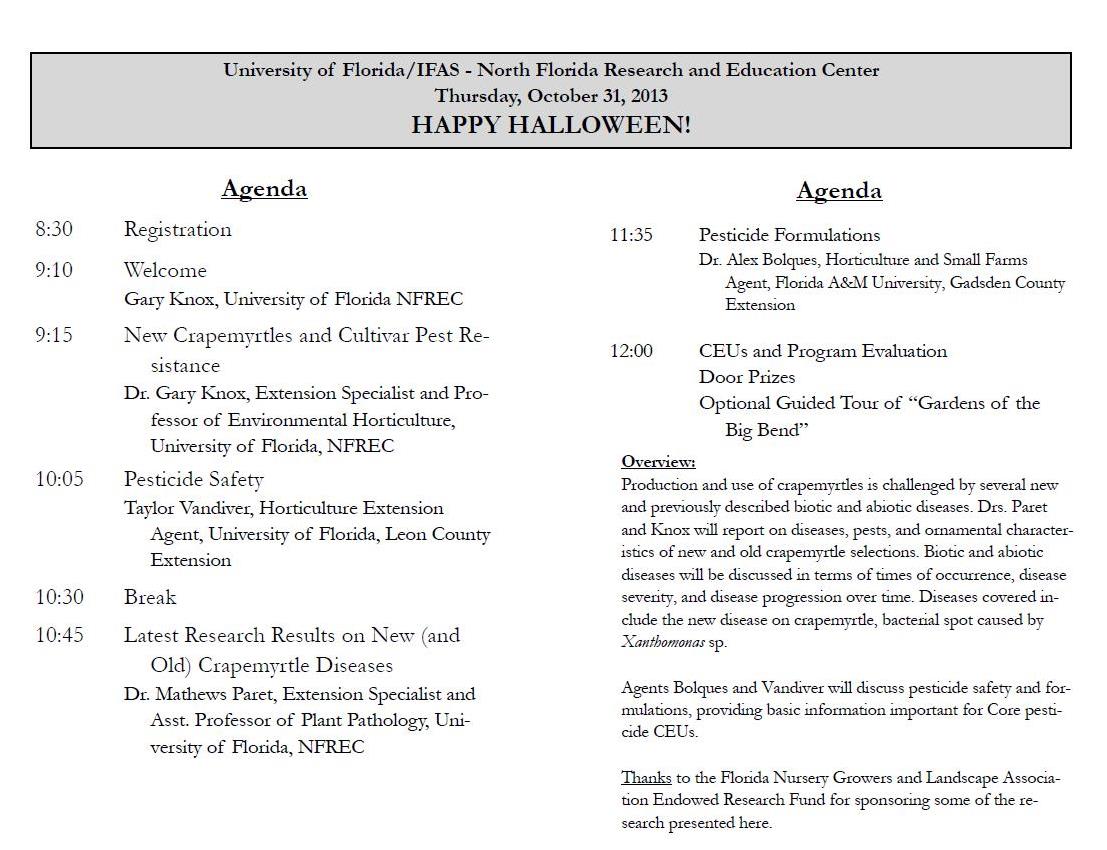by Alex Bolques | Oct 25, 2013
 The avid gardener has heard on many occasions that fall is the best time of the year to plant trees and shrubs. Correct! Now is the time to start a fruit orchard or an edible landscape. As the seasons transition into much cooler weather, now is the ideal planting season for hardy trees, shrubs and ground covers (Trawick, 2013).
The avid gardener has heard on many occasions that fall is the best time of the year to plant trees and shrubs. Correct! Now is the time to start a fruit orchard or an edible landscape. As the seasons transition into much cooler weather, now is the ideal planting season for hardy trees, shrubs and ground covers (Trawick, 2013).
In the fall, plants require less water to get established and stress factors associated with planting in full sun are reduced. Although weather is cool, soil temperatures continue to be warm enough throughout the season to promote root growth. Thus by planting in the fall, the plant becomes more established by having a better and more vigorous root system than a plant that is planted at springtime.
Deciding what to grow sometimes is limited by what is available in a given area. Mail and online sales can be tricky if for those unaware about which fruit species perofrms best in Northwest Florida. To aid in this planning process, a link to a University of Florida IFAS publication (HS1218) is included that contains a directory of certified Florida nurseries offering fruit and nut crops. While it was developed to assist farmers locate fruit and nuts cultivars in Florida, it is helpful to begin thinking about what to grow and where to find it. The publication also lists recommended fruit and nut species and cultivars for North Florida, including north-central Florida.
Fruitscapes is a University of Florida website dedicated to fruit trees in Florida, which will increase understanding of fruit tree cultural and pest management requirements for all readers. Also explore “Temperate Fruit Crops” . Bookmark this webpage and refer to it as needed. Also, consult with your county extension office in your area.
by Les Harrison | Oct 25, 2013
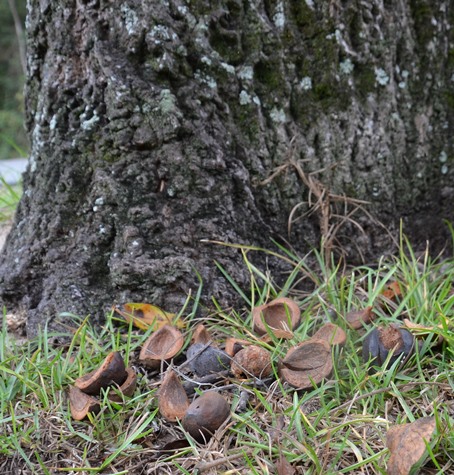
Hickory nuts are popular with squirrels in the autumn.
There is a lot to be gained from having a tough reputation. Only those with a stout disposition or lack of good sense will dare to make a challenge to the individual who hold this distinction.
Unbending, rigid and durable are descriptors which invoke a firm, if not dogmatic, state of resiliency. With this enviable identity, many compare themselves and some assimilate the traits they most admire.
Andrew Jackson is a good case in point. The seventh president grew up on the frontier, dueled with enemies, and commanded an army during the War of 1812 where he was given the nickname Old Hickory.
Like Jackson, hickories are native to North America and are highly valued for their long wearing qualities. While this president no longer visits north Florida, there are plenty of hickories growing in home landscapes.
There are three hickories in panhandle Florida, bitternut, mockernut and water. The water hickory is usually found in wetter areas and the other two species in upland sites.
This genus, Carya, is found in North America and East Asia. The term identifying this genus was coined in Greek mythology and originally referred to a woman who was transformed to a walnut tree.
Karya, or so the story goes, was the daughter of a divinely well-connected king who had gained favor with Apollo. As a courtesy, Karya and her sisters were granted the skill of prophecy from the deity.
As is typical of Greek myths and soap operas, the sisters misused their gift of divination and were punished. Karya was turned into a walnut tree by her boyfriend who was the mythological god of winemaking and ritual madness.
Legendary tragedies aside, hickory trees have a wide variety of contemporary uses commercially and environmentally.
The wood of hickories is relatively hard and is used where a durable and sturdy material are required. Tool handles and flooring are two of the most common uses today.
Prior to the development of modern composite materials, hickory lumber was utilized in vehicle parts, golf club shafts, archery equipment, and a variety of other uses which anticipated hard use. Hickory was originally used to construct baseball bats until ash gained popularity because of its lighter weight.
Hickories are an excellent specimen tree in a landscape. These tall, deciduous trees usually grow from a single trunk and provide excellent shade during the summer.
The leaves can deliver a bright yellow show in the autumn and, if planted on the south side of a home, provide passive solar heating during the cooler months. Mockernut and water hickory nuts have been used in recipes, but are difficult to crack.
One caution is not to establish a hickory near a home or other structure. Squirrels will quickly identify the nuts as a food source and can be quite messy.
Another problem issue is if a tree falls during a storm. The logs are quite heavy and will likely crush anything they hit, especially homes and vehicles.
Hickory is popular and long burning firewood. It is also widely used by bar-b-q devotees who prize the distinct flavor it imparts.
To learn more about hickory trees in north Florida , visit the nearest UF/IFAS County Extension Office or read this infromative publication on the water hickory.
by Taylor Vandiver | Oct 25, 2013
Caution…Worms at Work!
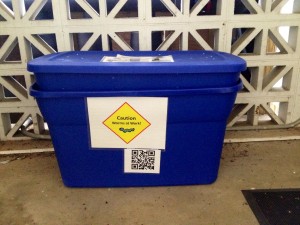
Vermicomposting bin at the Leon County Extension Office.
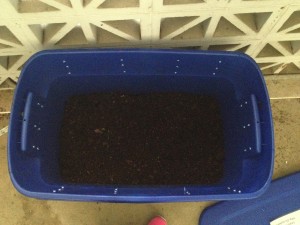
It’s difficult to see, but our worms are hard at work composting leftovers!
Many home gardeners may have thought about composting, but may not have the time, the space or, let’s face it, the patience. Well then vermicomposting is ideal to satisfy those conditions! Vermicomposting is the process of using worms and micro-organisms to turn food waste into a nutrient-rich compost called worm castings. Worm composting bins can take up less space than traditional composting bins and can even be kept inside.
Bins can be purchased or made at home, for those who want to compost on a budget. If the home gardener is planning on making their own there are a few things that should be considered. Make sure that the container won’t absorb too much water (such as cardboard), because worms need to stay moist. The container should also be made of a non-clear material. A good example would be 1-18 gallon plastic (not clear) container or a Styrofoam container with a lid. Holes need to be drilled about 4 inches from the top of the bin. Covering the air holes with a type of screen is a good idea to prevent the escape of the composters.
After the bin has been constructed bedding (shredded newspaper, etc.) will need to be placed at the bottom. The bedding should be moistened and then potting soil added on top of that. This will provide a good living habitat for your worms. The Number of worms that need to be added will depend on the container size. When getting worms, make sure to use red wigglers (Eisenia fetida) or African Nightcrawlers (Eudrilus eugeniae). Unlike earthworms found in the garden, these worms thrive in composting bin conditions. They can usually be found at bait stores or local worm farms.
Now its time to put them to work! Worms can be fed daily or weekly. One pound of worms can be fed about half a pound of kitchen scraps per day. When adding scraps avoid using animals products like eggs, cheese or meat. The ideal meal should include small scraps of vegetables, fruits, coffee grounds, bread and paper. When adding the scraps be sure to bury them under the soil. Store the worm bin in an area that does not receive direct sunlight and stays at a constant temperature of about 60 to 80 degrees. Be sure to have a lid for your container, this will keep light out and will also help prevent the appearance of flies. One pound of worms can turn 65 pounds of garbage into garden compost in about 110 days. Compost should be harvestable in a matter of months!
Vermicomposting is a great way to compost for those living in an apartment or those that have kitchen scraps as a main source of compost materials. Worm castings are used just like normal compost. Add them to plants and gardens as a soil amendment, use them in potting soil, or make a compost tea.
For more information contact your local UF/IFAS Extension Office.
by Matthew Orwat | Oct 23, 2013

Image Credit: UF IFAS EDIS
From Dr. John P. Hayes”
“Florida Crossroads made a 28 minute video entitled “Seeds of Change” featuring the IFAS breeding efforts to create new varieties of blueberries, strawberries, tomatoes, and other crops, and the ways that these programs have influenced Florida industry.
For those of you who are familiar with our breeding programs, you’ll enjoy seeing some of our scientists on the screen. For those who aren’t familiar with IFAS development of new varieties, it is well worth the watch and I’d encourage you to do so. Our breeding program and the scientists engaged in breeding at UF are world class.”
 The avid gardener has heard on many occasions that fall is the best time of the year to plant trees and shrubs. Correct! Now is the time to start a fruit orchard or an edible landscape. As the seasons transition into much cooler weather, now is the ideal planting season for hardy trees, shrubs and ground covers (Trawick, 2013).
The avid gardener has heard on many occasions that fall is the best time of the year to plant trees and shrubs. Correct! Now is the time to start a fruit orchard or an edible landscape. As the seasons transition into much cooler weather, now is the ideal planting season for hardy trees, shrubs and ground covers (Trawick, 2013).





